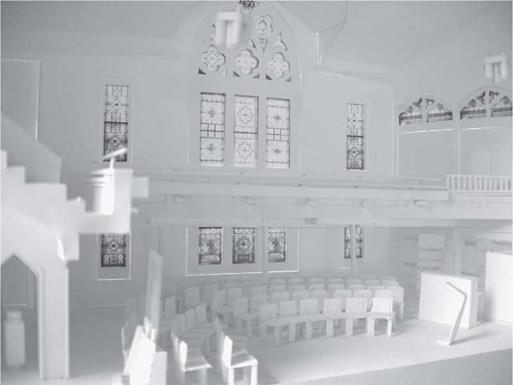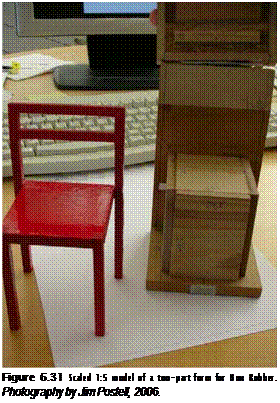Scaled models of furniture placed in interior models show relationships between furnishings and interior space and reveal notions of scale, layout, and proportion. Models of buildings and interior spaces can be fabricated precisely and relatively quickly out of white museum board, foamcore, or basswood (Figure 6.30). These models serve as excellent means to study furniture in its intended spatial context. Interior models can be fabricated at a small scale (e. g., l/s inch = 1 foot 0 inches or ЛА inch = 1 foot 0 inches) to resolve general spatial relationships so that decisions about material selection, color, and texture can be explored in rendered drawings or in larger, more detailed models (e. g., 3 inches = 1 foot 0 inches) once the overall spatial context is resolved.
Materials can inspire design ideas. Working with materials in the development of design increases the effectiveness of the design process. In this regard, material boards and material sample arrangements are effective means of helping designers consider physical and visual materials for interior space, furniture, or a building. Composing material boards is an art. Consequently, the presentation can either inform and inspire or misinform and mislead. The time and effort required to compose material boards are significant investments. Designing with immediate access to materials is the key point.
 |
 |
The tooling and molds that produce cast or molded elements are essential to preproduction testing of mass-produced furniture. It was necessary to make a rough scaled model of a two-piece mold (Figure 6.31) in order to understand how to produce Non Rubber, a chair
 designed by Boris Berlin of Komplot Design (Figure 6.32). The mold would eventually be made out of aluminum, but the quick study model gave the designers and fabricators confidence in how to proceed with the design. This knowledge was used to refine important details of the single-formed iron and polyurethane rubber (PUR) chair so that it could be produced and easily released from an aluminum mold.
designed by Boris Berlin of Komplot Design (Figure 6.32). The mold would eventually be made out of aluminum, but the quick study model gave the designers and fabricators confidence in how to proceed with the design. This knowledge was used to refine important details of the single-formed iron and polyurethane rubber (PUR) chair so that it could be produced and easily released from an aluminum mold.
Tools, materials, and digital fabrication technologies have significantly evolved over the past 20 years. With the advent of plaster printers and five-axis computer numeric controlled (CNC) devices, working prototypes are easier and more economically feasible to produce than in the past.
In the digital age, will furniture designers maintain an understanding of when to use a hand block plane or the distinction between shellac and tung-oil finishes on wood furniture? What might happen when designers are able to go directly from digital design to digital production entirely by digital means using only digital tools? The challenge to keep current and maintain comprehensive breadth and extensive depth regarding hand, machine, and digital technologies affects every designer today and requires constant effort.
 |
It often takes an enormous number of sketches, explorations, and iterative model studies to end up with a design that is well composed, technically resolved, comfortable, functional, aesthetically pleasing, and economically feasible. Designing furniture has "iceberg-like" connotations in the sense that 90 percent of the time spent on design is typically used to explore alternative variations and subtle iterations, many of which are abandoned in the process of design. Processes of exploring and refining design ideas are critical, even if the efforts do not seem apparent in the final result.



